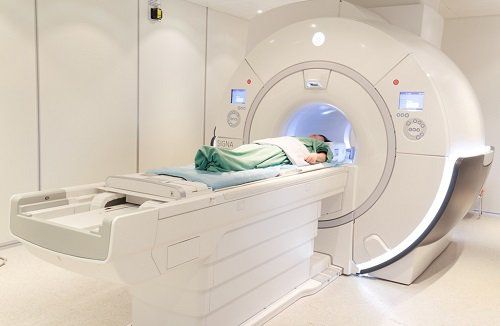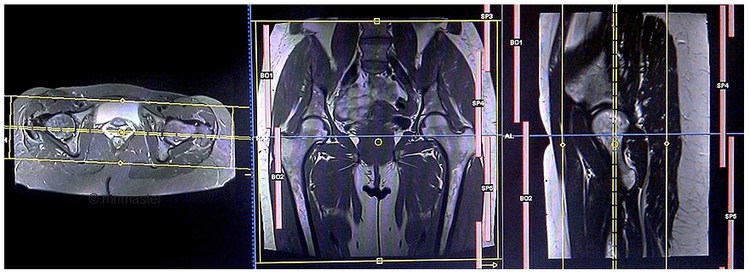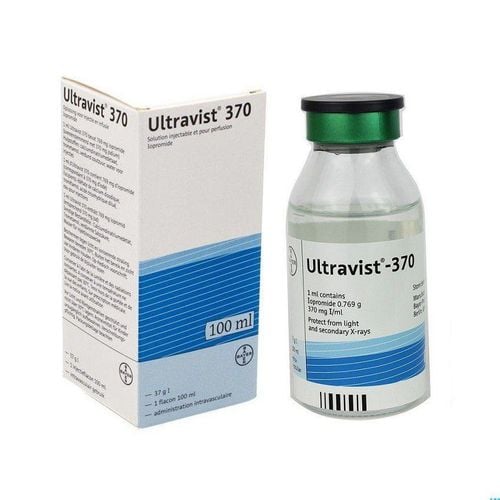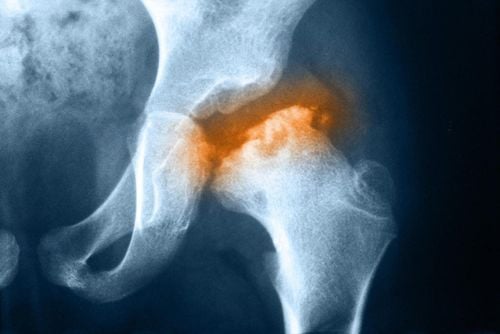This is an automatically translated article.
The article is professionally consulted by Master, Doctor Nguyen Thi Mai Anh - Doctor of Radiology - Department of Diagnostic Imaging and Nuclear Medicine - Vinmec Times City International Hospital
Aseptic necrosis of the femoral head is a dangerous disease that easily affects one or both sides of the hip joint with a high risk of joint replacement. Musculoskeletal MRI is an imaging method that helps to observe the risk signs and diagnose the disease.
1. Overview
Aseptic necrosis of the femoral head (also called “avascular necrosis”) usually occurs due to decreased or lack of blood supply to the femoral head. The marrow in this area is infarcted and necrotic, spreading to the ends of the bones. The sockets are gradually missing, the femoral head is flattened, the subchondral bone is broken, and the hip joint degrades and gradually loses function, which can lead to disability.
Aseptic necrosis of the hip is most common in middle age (20-50 years old), more common in men than women (80%).
Possible causes of aseptic necrosis of the hip include:
Spontaneous: Usually accounts for 50% of cases. Secondary trauma : Such as dislocation and fracture of the femoral neck . Non-traumatic secondary: 70% of cases of aseptic necrosis of the femoral head are due to alcoholism or prolonged high-dose corticosteroid use. The remaining 30% of cases are due to emphysema (divers, miners), sickle cell disease, autoimmune disease (rheumatoid arthritis, lupus erythematosus), diabetes mellitus, enteritis, transplantation. visceral disease, hyperactivity and idiopathic thromboembolic disease, dyslipidemia, pregnancy.

Hoại tử vô khuẩn khớp háng thường xảy ra nhiều hơn ở nam giới
2. Identification signs
Injury can occur on one or both sides of the hip, but up to 70% of cases of aseptic necrosis of the hip occurs on one side.
Signs of aseptic necrosis include:
Early stage: Occasionally, the patient may have intermittent pain in the injured hip or knee joint, but the hip's mobility is not enough. Patients are not restricted. Late stage: Limited range of hip movement: the patient has difficulty squatting or sitting, cannot rotate or adduct the hip normally, feels pain in the hip joint on the injured side. Pain intensity comes on gradually, increases with walking or standing for a long time and decreases with rest. To diagnose aseptic necrosis of the hip, one can use biochemical, hematological, X-ray, CT scan and magnetic resonance imaging (MRI) tests.
Up to now, musculoskeletal MRI is considered the earliest imaging tool to detect aseptic necrosis of the hip joint. Necrotic lesions of the hip on MRI are shown to be decreased in image signal in the lateral femoral head and increased in the medial signal.

Chụp MRI là phương pháp chẩn đoán hình ảnh giúp phát hiện hoại tử vô khuẩn khớp háng sớm nhất
3. Diagnosis of aseptic necrosis of the hip by MRI
Musculoskeletal MRI allows to observe the hip joint in 3D space, helping to detect damage to articular cartilage, subchondral bone, ligaments, bone marrow, synovial membrane, joint cavity and periarticular tissues.
With the advent of CT and MRI, in 1993 ARCO (Association Reseach Circulation Osseous) proposed to divide 6 levels of aseptic necrosis of the hip. This classification system is currently being used very commonly:
Grade 0: This is the stage where the lesion is too small to be detected on X-ray, CT or musculoskeletal MRI. This level is also known as the disease void.
Level 1: Damage to blood vessels occurs. X-rays showed no abnormalities, but CT and MRI were visible. The patient begins to feel intermittent dull pain in the injured hip or knee joint pain.
Level 2: X-ray will clearly show the radiolucent area and the sclerotic area showing the process of infarction, bone scan. Whereas CT and MRI allow definitive diagnosis. This stage corresponds to the process of bone loss and bone infarction, the patient will feel pain when walking, active and less pain when resting.
Level 3: At this stage, the bone is broken below the cartilaginous surface, when the crescent-shaped radiolucent image is observed under the cartilaginous surface, the femoral head is still intact and not flattened.
Level 4: Under CT, MRI images, the cartilage surface is flattened because the ability to support the cartilage is weakened. However, flattening of the femoral head is difficult to observe on conventional straight and inclined X-ray images. The mortar at level 4 is still intact.

Chụp MRI cho phép quan sát được khớp háng trong không gian 3 chiều
Level 5: Observation of joint space narrowing and hardening in the acetabulum and femoral head. At the edge, the bone buds are deformed, causing the patient to suffer constant pain. The condition of aseptic necrosis of the hip joint is severe and difficult to salvage.
Level 6: The highest stage, severe aseptic necrosis of the hip. Musculoskeletal MRI showed that the joint space and cartilage surface disappeared, and the femoral head was broken. The patient suffered from severe pain and difficulty walking.
Currently, the Department of Diagnostic Imaging is one of the key departments of Vinmec International General Hospital, equipped with the most modern and advanced equipment in the country as well as in the region. The department has 6 ultrasound rooms, 4 DR X-ray rooms (1 full-axis machine, 1 brightener, 1 synthesizer and 1 mammography machine), 2 DR mobile X-ray machines, 2 cutting rooms. multi-row computer class with receiver (1 128-series and 1 16-series), 2 Magnetic Resonance imaging rooms (1 3 Tesla machine and 1 1.5 Tesla machine), 1 interventional angiography room with 2 planes and 1 room measure bone mineral density.
The medical team at the Faculty are well-trained at home and abroad. Especially when coming to Vinmec International General Hospital, patients do not need to wait long, have a quick examination time and are carefully guided by a team of experienced medical staff on the use of medicines and instructions. Lead positive lifestyle changes so that patients can easily adhere to their treatment management.
Any questions that need to be answered by a specialist doctor as well as customers wishing to be examined and treated at Vinmec International General Hospital, please register for an online examination on the Website for the best service.
Please dial HOTLINE for more information or register for an appointment HERE. Download MyVinmec app to make appointments faster and to manage your bookings easily.













